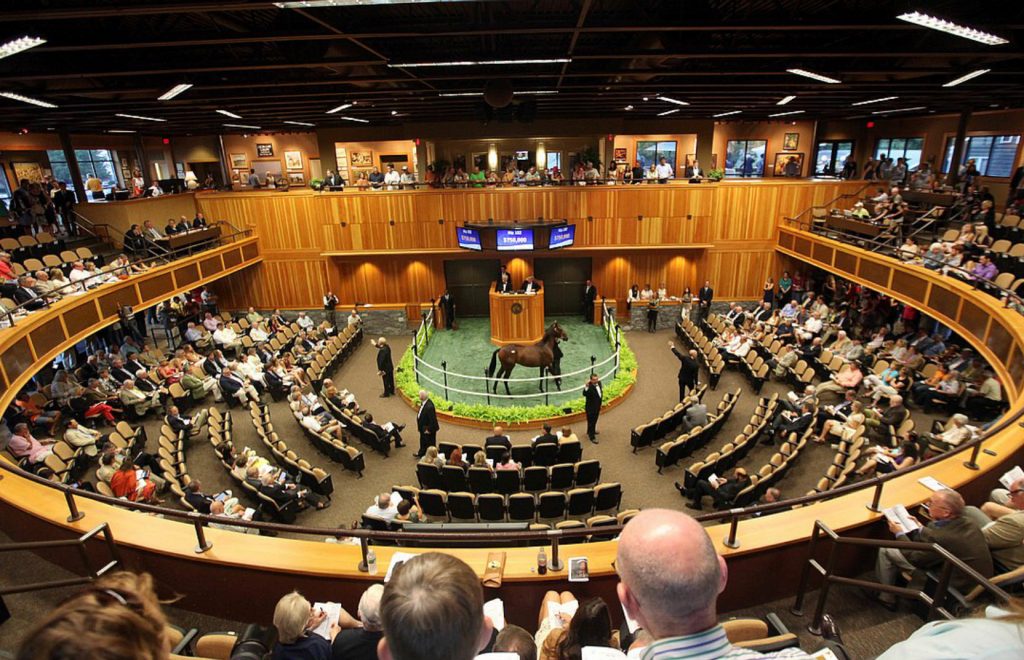
Thanks to pastthewire.com for asking me to contribute. I’ll be writing about the business of racing, as I’ve done over the years in my blog of the same name. And, since we’re just about to start the two-year-old sales season, let’s take a look at how those sales came to be.
Back in 1953, there were exactly four thoroughbred farms in Marion County, Florida. The 1953 foal crop in Florida was all of 79 horses. But one of those, Needles, went on the win the Kentucky Derby and the Belmont Stakes, then retired to stud in Florida, and the state’s breeding industry was born.
Based largely on Needles’s success, the Ocala-area farms changed the way young horses are sold. Before World War II, and continuing into the 1950s, most thoroughbreds were raced by their breeders, who were typically wealthy individuals with their own farms. Some foals would be sold at yearling auctions, but the game was mostly breed-to-race. Then, in the 1950s, newly rich owners came into racing, seeking glory on the track without the years of breeding. Ultimately, that led to the emergence of two-year-old (in racing parlance, “juveniles”) sales, offering horses that were almost ready to race.
In 1958, Ocala Stud sold its entire two-year-old crop off the farm, and the Florida Breeders Sales Co. began selling two-year-olds at Hialeah; often those two-year-olds would be racing there within days or weeks. Fast-forward to 1974, when the late Norman Casse and his fellow Ocala breeding pioneers decided to organize their own sales company; Ocala Breeders Sales Co. (OBS) held its first juvenile sale in January 1975. Forty-five years later, two-year-old sales are a major part of the thoroughbred marketplace. This year’s two-year- old sales season starts in Ocala March 17 and 18, to be followed by OBS sales in April and June, by Fasig-Tipton sales at Gulfstream in April, Timonium MD in May and at Santa Anita in June, by a Keeneland sale in April, and by a variety of small regional auctions.
From being non-existent some 60 years ago, two-year-old sales have become big business. Last year, 2,312 juveniles, or roughly 10% of the foal crop, were sold at auction, with an average price of over $90,000. Yearling sales are still a bigger piece of the market – almost 7,000 yearlings were sold at auction last year – but the juvenile sales are a major element in what’s now a year-round sales calendar. And the sales have created a previously unknown industry – pinhooking, in which horse traders buy yearlings or weanlings and then resell them at the two-year-old sales. Pinhooking operations may now outnumber breeding farms in the Ocala area, relying on the warmer Florida weather and the high levels of calcium in the grass to develop horses quickly, so they look like promising athletes by the time the sales come around in the spring.
As the sales have matured, the demands of buyers have escalated. Nowadays, bloodstock agents sit up in the grandstand and hand-time not merely the 1- or 2-furlong breeze that each horse runs, but also the horse’s “gallop-out” around the turn after the finish line. Buyers use slow-motion video and ultrasound scans of horses’ hearts in addition to the traditional physical inspections and review of vet records. And buyers are very, very picky. At most of the sales, barely half of the horses listed in the catalogue end up going to new homes. The rest are either scratched by their consignors because they couldn’t meet the demanding prep schedule or don’t draw a bid higher than the seller’s reserve price.
The key to selling a horse for lots of money at a two-year-old sale is for the horse to breeze fast – very fast. The bullet breezes at the sales are typically close to 10 seconds flat for an eighth of a mile and 21 seconds for a quarter, faster than those horses will ever run again. And while there’s a general correlation between fast breezes and later success on the racetrack, it’s only a modest one, and the opportunity for mistakes abounds.
Back in 2006, at the Fasig-Tipton sale at Calder, a Forestry colt subsequently named The Green Monkey recorded the fastest breeze of the sale and prompted a bidding war between the Coolmore juggernaut from Ireland and Sheikh Mohammed al Maktoum of Dubai, pushing the horse’s price to a world-record $16 million. The Green Monkey, running in Coolmore silks, never won a race, earning a grand total of $10,000 on the track, and was quickly retired to an ignominious stud career in Florida. It’s easy to make mistakes; maybe if Coolmore and the Sheikh’s people had focused a little more, they would have noticed that the colt did his 9.8-second breeze in a rotary gallop, which can’t possibly be sustained for any real race distance. But, oh well, it’s only money.
Occasionally, sellers try to convince prospective buyers that the hell-bent-for-leather breeze is a bad idea, and return to the original juvenile sale format, where horses just galloped past the crowd. Pinhooker Kip Elser has had some success doing that recently, and Frank Stronach tried for some years to sell his Adena Springs Farm’s juveniles at the farm with just a gallop show, but mostly speed still rules, not necessarily to the benefit of the horses that are pushed hard to make the sale in time, rather than going through a longer period of gradual bone development.
This year’s OBS March sale has catalogued some 681 horses, a sizeable increase from recent years, including half a dozen by Triple Crown winner American Pharoah and one by Frankel, arguably the best horse of this century.
Virtually all the leading North American sires are well represented, and there are more Kentucky-breds in the catalogue than Florida-breds. So, even as the Florida foal crop has declined drastically since the 2008 financial crash, OBS’s sales business, designed originally as a way of marketing the state’s own foals, has morphed into what amounts to a nationwide profit center. Thanks, pinhookers.
At last year’s March sale, 306 of the 577 horses originally listed in the catalogue ended up being sold, at an average price of nearly $147,000. With an expanded catalogue this year, it may be hard to match that average. I’ll be writing about what actually happens at this year’s sales, and we’ll see. If you have a weanling or yearling that doesn’t sell, there are always the two-year-old sales. But if your two-year-old doesn’t sell, suddenly you have very few options.
So it’s a high-pressure situation; it’ll be interesting to see who the winners and losers turn out to be.


